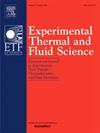斜液滴撞击薄壁薄膜溅射和状态阈值的表征
IF 3.3
2区 工程技术
Q2 ENGINEERING, MECHANICAL
Experimental Thermal and Fluid Science
Pub Date : 2025-04-16
DOI:10.1016/j.expthermflusci.2025.111493
引用次数: 0
摘要
本研究通过实验研究了液滴对薄壁薄膜的斜向撞击,为冠状层的形成、飞溅类型和阈值建模提供了新的见解。在薄膜厚度 δ=0.22 和流体(异丙醇)保持不变的情况下,通过改变撞击角 α 和韦伯数 We,确定了不同的飞溅类型。飞溅类型包括仅从冠状物正面或侧面喷出的二次液滴、冠状物与薄膜相互作用引起的飞溅以及 90° 类飞溅。此外,还观察到这些机制的组合,如同时从正面和侧面喷溅,因为它们的触发机制是独立的,并允许进行制度叠加。为描述不同的飞溅类型,我们绘制了一种机制图和阈值公式。正面飞溅极限位于 cos(α)We=128 时,这表明 cos(α) 是韦伯数之外的相关物理量。侧溅只取决于壁面法向韦伯数(Wen=425)。如果韦伯数足够高,冠膜相互作用会在α<60°以下发生,而如果撞击角超过α>81°,则会出现类似于α=90°时的飞溅。本文章由计算机程序翻译,如有差异,请以英文原文为准。

Characterization of splashing and regime thresholds for oblique droplet impact on thin wall films
This study experimentally investigates oblique droplet impacts on thin wall films, providing new insights into crown formation, splashing types, and threshold modelling. Different splashing types were identified by varying the impact angle and Weber number , keeping the film thickness and fluid (isopropanol) constant. The splashing types include secondary droplet ejection only from the front or only from the sides of the crown, splashing caused by crown-film interaction, and 90°-like splashing. Combinations of these mechanisms, such as simultaneous front and side splashing, were also observed, as their triggering mechanisms are independent and allow for a superposition of regimes. A regime map and threshold formulations were developed to describe the distinct splashing types. The front splashing limit lies at , which reveals that the is the relevant physical quantity beside the Weber number. Side splashing depends solely on the wall-normal Weber number (). Crown-film interactions occur below if the Weber number is high enough, while splashing similar to that seen when is observed if the impact angle exceeds .
求助全文
通过发布文献求助,成功后即可免费获取论文全文。
去求助
来源期刊

Experimental Thermal and Fluid Science
工程技术-工程:机械
CiteScore
6.70
自引率
3.10%
发文量
159
审稿时长
34 days
期刊介绍:
Experimental Thermal and Fluid Science provides a forum for research emphasizing experimental work that enhances fundamental understanding of heat transfer, thermodynamics, and fluid mechanics. In addition to the principal areas of research, the journal covers research results in related fields, including combined heat and mass transfer, flows with phase transition, micro- and nano-scale systems, multiphase flow, combustion, radiative transfer, porous media, cryogenics, turbulence, and novel experimental techniques.
 求助内容:
求助内容: 应助结果提醒方式:
应助结果提醒方式:


